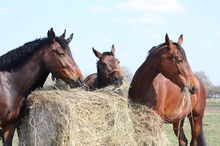It’s a long, long way from Queensland, Australia to Stillwater, Oklahoma. The University of Queensland had palm trees and kangaroos. Oklahoma State has pickup trucks and cowboy hats.
What could uproot a young woman and move her halfway around the world?
Two words: Laminitis research.

Insulin as a factor in laminitis in horses
Better understanding of the insulin-signaling processes in the horse's foot during increased insulin availability will improve our overall understanding of laminitis.
Melody de Laat was a rising star back in Queensland. She earned a PhD as part of the world-renowned Australian Equine Laminitis Research Unit. Director Chris Pollitt PhD MRCVS instilled in her the curiosity and the drive to earn not just a doctorate, but a place in the small but significant legion of successful laminitis researchers scattered around the world.
Working with Dr. Pollitt, Melody discovered that receptors designed to receive insulin-like growth factor 1 (IGF-1) may be binding to insulin instead in horses when horses have high levels of insulin.
This groundbreaking discovery may enable scientists to develop strategies to try to block IGF-1 receptors from receiving insulin and prevent the condition of hyperinsulinaemia (“insulin resistance”) from occurring.
The equine foot is very dependent on glucose for metabolism, but it is not dependent on insulin to deliver that glucose. Horses have a large number of IGF-1 receptors in their feet, but no insulin receptors.
Pollitt’s team theorizes that these IGF-1 receptors are being stimulated by insulin that mimics insulin-like growth factor 1 and is binding to these receptors.
When this happens, the lamina stretch, detach and laminitis occurs.
To continue her research, Melody accepted a post-doctoral position at Oklahoma State University College of Veterinary Medicine. Even though she has only been there a few months, she’s hard at work.
Melody’s new research at Oklahoma State is funded by your donations through the Animal Health Foundation. Will her research make a difference to horses at risk for laminitis? The Animal Health Foundation believes it will.
The current AHF-funded project being investigated by Drs. Lacombe and de Laat at Oklahoma State University aims to investigate how glucose transport and insulin signaling are regulated in the heart, muscle and lamellar tissues (in the feet) of horses that have laminitis associated with hyperinsulinaemia. This will be compared to glucose and insulin regulation in the same tissues of normal horses.
Why is this laminitis research so important?
- This project will study tissues that have not been previously examined to assess the pattern of glucose metabolism during very high blood insulin levels.
- The work will build on the limited available data on lamellar metabolism in horses with insulin-associated laminitis by investigating new topics such as intracellular signaling and inflammatory pathways in the foot and how they relate to glucose transport.
- Characterization of the changes in glucose transport during conditions of high insulin will provide new insights into the mechanisms of insulin resistance in horses and may facilitate the development of novel therapeutic interventions for the management of metabolic diseases in horses.
- Finally, better understanding of the insulin-signaling processes in the foot during increased insulin availability will improve our overall understanding of laminitis. This may lead to new avenues for disease treatment and prevention.
The Animal Health Foundation is encouraged by Melody’s continued involvement in laminitis research, and by her move to the United States. We are confident that her research will yield results that will move our efforts forward and ever closer to our goal of ending this terrible disease.
Donors who contribute to Animal Health Foundation laminitis research projects can be assured that 100 percent of their donations will go directly to laminitis research. AHF is dedicated solely to researching and ending this terrible disease.
Learn more at Animal Health Foundation.
Resources:
The Animal Health Foundation has provided financial support for international laminitis research since 1985. Many major breakthroughs in the understanding of the disease have been accomplished with AHF funding by researchers at the Australian Equine Laminitis Research Unit (University of Queensland), University of Missouri College of Veterinary Medicine, and Cornell University, as well as by independent professional researchers like forage specialist Kathryn Watts of safergrass.org.
Research funded by the all-volunteer, not-for-profit organization, is provided by individual donors from throughout the United States, many of whom are horse owners, veterinarians and farriers who struggle with the disease and want to see research advance.
AHF is dedicated exclusively to funding laminitis research and to educating people about the disease.
Visit http://www.ahf-laminitis.org/p/donate.html to make a direct donation.
The Animal Health Foundation hosts an educational YouTube channel with videos covering the types and phases of laminitis, with information for horse owners, veterinarians and farriers.
